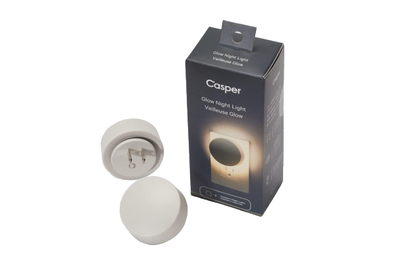I know, you’re probably balking at the price. (“She paid how much? For night-lights?”) Believe me, I did at first, too. If it hadn’t been for an Amazon gift card burning a hole in my pocket, I probably would have settled for something cheaper. But I didn’t.
Now, after relying on this set of night-lights for two years, I’ve come to consider them a nightly essential, and they’re paying off in their per-use cost; if I need to replace them, I won’t hesitate to buy them again at full price.
As soon as I took the lights out of the box, I was impressed with their quality and good looks. Off-white and round, with a smooth but not too shiny finish, they’re aesthetically pleasing. The circular front is slightly convex, just enough for each night-light to look like an artful, tasteful object (if you happen to notice it).

The lights have lived up to their looks, too. They automatically turn on and emit a warm, pleasant glow when they sense that a space is dark. Sometimes that means there’s a bit of a lag between what I would consider dark versus what the night-light considers dark, but mostly I appreciate that the light comes on automatically, and I don’t need to think about it.
They also have two different modes: one that emits an ambient, low glow (what Casper calls Sleep Mode) and one that activates a motion sensor to increase that baseline brightness when you walk by (Night Owl Mode). You can toggle between the modes using a switch on the back of the light, but I tend to keep mine on the motion-sensing mode because I like the additional lighting when I walk into the room.

The big thing for me is that these night-lights look great both when they’re on and when they’re off. When they’re on, they’re backlit, reflecting off the wall behind them, so they’re never too bright—they are (to overuse a word) glowy. Off, they seamlessly blend into the background and don’t call attention to themselves, which is exactly what I want in a night-light.
Although T Magazine and Architectural Digest are certainly not coming over for a house tour anytime soon, these understated night-lights allow me to maintain the illusion that someone might be interested in scrolling through glossy photos of my modest space.
For all the good things I have to say about these night-lights, there are a few things I don’t love. Although they don’t necessarily cover up both outlets, they are on the larger side. You might not be able to plug in something bulky like a hair dryer or a laptop charger at the same time, depending on your outlet configuration and where you want to use the night-light in your home.

However, I’ve found this to be a minor inconvenience in my bathroom because I don’t use a hair dryer or other bulky items often. For my everyday needs, such as charging my electric toothbrush or phone, it isn’t an issue. But if you use larger items more regularly, you might find the night-light’s size more annoying than I do.
Also, you can’t replace the bulb when it burns out, as you might be able to with other night-lights, so you have to buy entirely new night-lights when these burn out. According to Casper, the lifespan of these night-lights is about one to two years, depending on how frequently you use them.
That said, I’ve owned mine for two-going-on-three years, and they’re still going strong. A colleague, editor Katie Okamoto, has also owned hers for two years and has yet to encounter a burnt-out bulb. (She has one to light up her kitchen when she’s grabbing a snack or a glass of water at night.)
I’ve since moved out of the apartment with that dark, windowless bathroom I initially bought these night-lights to illuminate. But I plugged one of these night-lights in my new bathroom anyway. I’ve grown rather attached to its reliable glow, and I’ll replace it when it does eventually burn out.
This article was edited by Katie Okamoto and Maxine Builder.





